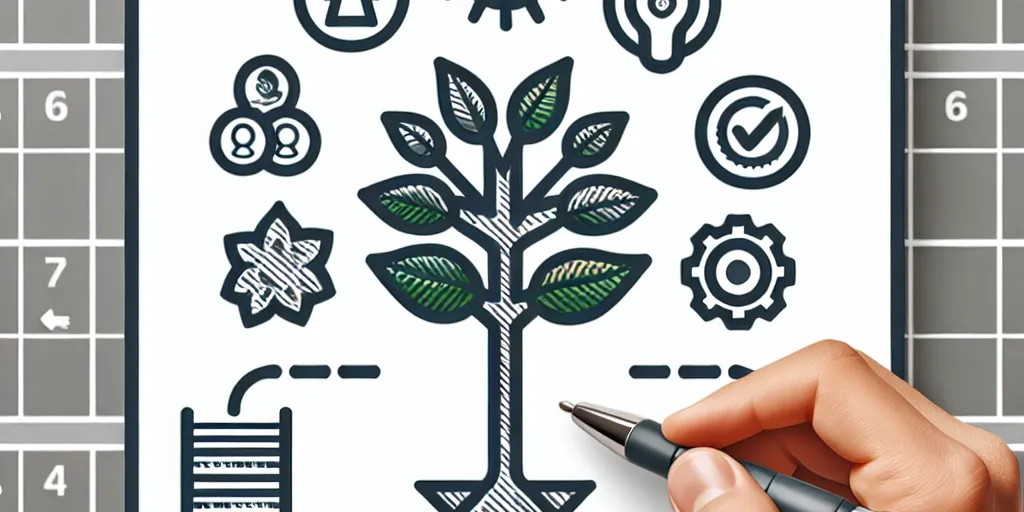· Seren Marlowe · self discovery and potential · 8 min read
Crafting Your Journey: Creating a Personal Development Action Plan
Empower Your Path: A Guide to Designing Your Personal Development Action Plan

Embarking on a journey of self-improvement requires not just a destination, but a clear route to follow. A personal development action plan is your roadmap to growth, self-improvement, and achieving your personal and professional goals. It’s all about taking those big, abstract ambitions and breaking them down into tangible, actionable steps. Like any good journey, having a plan ensures you make the most of your resources and stay on track even when the road gets bumpy.
A comprehensive personal development action plan doesn’t just serve as a checklist; it’s a living document that adapts with your evolving goals and circumstances. Ready to take control and set the wheels in motion? Let’s design a plan that’s as unique as you are.
Zoom in on the key areas we’ll explore to help you construct your personal development action plan:
- Understanding the Importance of a Personal Development Plan
- Identifying Your Personal and Professional Goals
- Breaking Down Goals into Actionable Steps
- Creating a Timeline for Your Personal Development
- Tracking Progress and Staying Motivated
- Adapting Your Plan for Long-Term Growth
Understanding the Importance of a Personal Development Plan
Navigating the complexities of life can often leave us feeling adrift, like a ship without a rudder. A personal development plan offers that much-needed direction, anchoring our desires to a structured approach. It’s more than just a to-do list; it’s a reflective process that helps us understand where we are, where we want to go, and how we’re going to get there. By putting pen to paper, we turn the intangible into the tangible.
Self-awareness is a key component of personal growth, and formulating a plan forces us to introspect, to recognize our strengths, and confront our weaknesses. This plan becomes a personal blueprint, helping us allocate time and energy towards what genuinely matters. With this strategic framework, we can avoid the pitfalls of aimlessness and make more informed decisions that align with our long-term vision.
Moreover, a personal development plan is not just about reaching career heights or mastering new skills - it’s about crafting a well-rounded life. By considering all facets of our existence - physical health, emotional well-being, social relationships, and intellectual growth - we create a balanced and fulfilling path to personal excellence.
Identifying Your Personal and Professional Goals
 Your personal development action plan should be a mirror reflecting your deepest aspirations and your core identity. Identifying your personal and professional goals is a foundational step in this self-molding process. It starts with asking the big questions: Who do you want to be? What impact do you wish to have on the world around you? How do you envision your ideal future, both in the personal realm and within your career?
Your personal development action plan should be a mirror reflecting your deepest aspirations and your core identity. Identifying your personal and professional goals is a foundational step in this self-molding process. It starts with asking the big questions: Who do you want to be? What impact do you wish to have on the world around you? How do you envision your ideal future, both in the personal realm and within your career?
Goal setting is a deliberate and thoughtful exercise. It is often said, ‘What gets measured, gets managed.’ By clearly stating your objectives, you give yourself a target to focus on. Goals act as benchmarks for progress, but they also provide motivation and purpose.
Strive not to be a success, but rather to be of value.
— Albert Einstein
Einstein’s words highlight the essence of meaningful goal-setting. While success can be a moving target, providing value is a constant pursuit. Align your goals with your values, your passions, and your desired contribution to society. When your personal and professional ambitions resonate with your inner truth, your personal development action plan transforms from a document into a calling.
Breaking Down Goals into Actionable Steps
Goals, no matter how ambitious, can seem less daunting when we translate them into actionable steps. This process is akin to deconstructing a complex recipe into individual ingredients and manageable instructions; suddenly, the exquisite dish appears achievable.
Transform your overarching goals into a series of smaller, specific actions by employing the S.M.A.R.T criteria—the objectives should be Specific, Measurable, Achievable, Relevant, and Time-bound:
- Specific: Clarify each step to avoid vagueness. Rather than ‘improve leadership skills,’ consider ‘attend a leadership workshop.
- Measurable: Determine how you will measure success. If your goal is to read more, set a target of ‘read one book per month.
- Achievable: Set realistic expectations to maintain motivation. Stretch your capabilities without overwhelming yourself.
- Relevant: Ensure each action aligns with your larger goals. Each step should be a building block towards your end objective.
- Time-bound: Define deadlines to instill a sense of urgency and pace your progress.
Breaking down your goals into these stepping stones not only simplifies them but also creates a structured timeline, turning your vision into a series of attainable endeavors. It’s essential to remember that the journey of a thousand miles begins with a single step—and your personal development action plan is your guide for each stride forward.
Creating a Timeline for Your Personal Development
 A timeline in your personal development action plan offers more than just due dates; it provides structure to your growth journey. Much like how a gardener plants seeds seasons in advance, you must plant the seeds of your future accomplishments with foresight and intentionality.
A timeline in your personal development action plan offers more than just due dates; it provides structure to your growth journey. Much like how a gardener plants seeds seasons in advance, you must plant the seeds of your future accomplishments with foresight and intentionality.
Consider a personal anecdote that illuminated this lesson for me: Once, I set a goal to learn Spanish. For months, progress was sporadic and slow. It was only when I penciled in a goal to practice daily for 30 minutes, leading up to a trip to Spain, that the words began to flow. It wasn’t magic—it was the power of a deadline that brought urgency and focus to my daily practice.
Deadlines act as checkpoints in your plan and create a rhythm for your endeavors. They help avoid procrastination and keep your objectives in the forefront of your mind. In your personal development action plan, map out key milestones and adjust your schedule to carve out time for your priorities. Remember, setting realistic time frames is crucial—overly aggressive timelines can lead to burnout, while too lax timelines may weaken your resolve.
💡 A positive mindset is the sunbeam that transforms storms into rainbows. It’s the art of seeing possibilities in every challenge, turning stumbling blocks into stepping stones. With a mind attuned to optimism, life becomes a canvas of opportunities, painted with vibrant strokes of resilience, gratitude, and an unwavering belief in brighter tomorrows.
Tracking Progress and Staying Motivated
The journey encapsulated within your personal development action plan is an adventure of self-discovery and improvement. However, maintaining the momentum of progress can be just as challenging as setting out the goals. That’s where the dual arts of tracking progress and staying motivated come into play.
Imagine your goals as mile markers on a highway. Tracking progress is the rearview mirror glance to appreciate how far you’ve come—a practice that bolsters your motivation. Regularly reviewing your achievements sharpens your focus on forthcoming objectives while nurturing a growth mindset. Take pride in the small wins. This reinforcement encourages your drive to push through plateaus and setbacks.
Incorporate a mix of techniques to track your advances. Use a journal, spreadsheet, or a dedicated app—whatever resonates with you. This visual representation of your progress is a powerful motivator. Celebrate the milestones, reflect on the lessons learned, and recalibrate as necessary. Remember, the personal development action plan you’ve crafted is not set in stone. It’s a living document that grows and adapts with you, propelling you forward on the path to your fullest potential.
Adapting Your Plan for Long-Term Growth
Your personal development action plan is not carved in marble; it’s a sketch on a canvas that evolves as your experience and insights grow. Adapting your plan for long-term growth is crucial to ensure it remains relevant and impactful. Life is unpredictable, and the ability to pivot and adjust your strategies is key to sustaining progress over time.
Embrace these principles to remain flexible and forward-thinking:
- Reflect regularly: Take time to consider what’s working and what’s not.
- Seek feedback: Constructive insights from mentors or peers can reveal new perspectives.
- Update objectives: As your life changes, so too should your goals and priorities.
- Stay informed: Keep learning and stay abreast of new methodologies or opportunities.
It is not the strongest of the species that survive, nor the most intelligent, but the one most responsive to change.
— Charles Darwin
Darwin’s observation about adaptability is as applicable to personal growth as it is to evolution. Your personal development action plan should be an organic guide, ready to shift and grow with you as you journey through life’s rich tapestry.
Remember, the most important step in personal development is taking action. Don’t wait for the perfect moment; start crafting your plan today, and adjust as you grow. Each action you take is a stepping stone towards a more fulfilling life.





